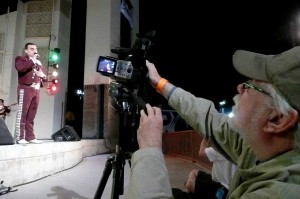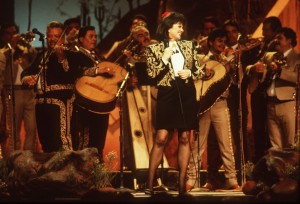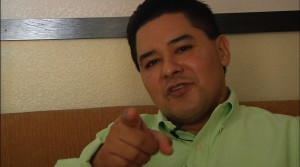Buckley launches film on mariachis’ rise
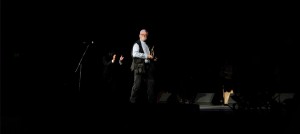
Daniel Buckley is inducted into the Mariachi Hall of Fame by the Tucson International Mariachi Conference board of directors at the 2013 Espectacular concert.
A new film is in production focusing on how mariachis and folklórico dancers have transformed Tucson, Arizona.
Former Tucson Citizen writer Daniel Buckley, who was recently inducted into the Tucson International Mariachi Conference’ Mariachi Hall of Fame, began shooting for the new documentary in late 2012 as he was wrapping up his film “Tucson’s Heart and Soul: El Casino Ballroom.” The film is called The Mariachi Miracle.
The idea evolved with Buckley during the 22 years that he worked for the Citizen. Year after year he would see young talent becoming better and better at younger and younger ages. But he also noticed something else. When he had gone to the University of Arizona in the early 1970s, very few Mexican Americans were among his classmates. But as the years went on, at the high school graduations he attended he noticed increased numbers of the mariachis and folklórico students he’d written about among those graduating. And when he talked with them, he learned that most were college bound.
What had happened? Tucson’s first youth mariachi, Los Changuitos Feos, which in 2014 celebrates 50 years in service to Tucson youth, set a precedent. It charged for its performances, invested the money and used it to send its graduates to college. The idea caught on and was repeated by other groups. Mariachi programs in local schools started at David Bilingual, Tucson High and later Pueblo, Sunnyside, Roskruge, Desert View and many more. These programs engaged the students, connected them with their culture and their family, and gave them both the reason and the tools to succeed in school and in the real world. They learned teamwork, and to be unafraid to speak out to people they might not even know.
Think back to when the Changuitos were started in 1964. The Tucson city council was instituting the dreaded Urban Renewal program which wiped out Mexican American barrios to make way for the convention center, and bulldozed Mexican businesses in the downtown. Even the remains of the Spanish Presidio fort, which cropped out around downtown, were destroyed in what was clearly an institutionalized attempt to eradicate Mexican American culture from view. Now fast forward fifty years to a time when the symbols of our city are the saguaro cactus and the mariachi. That’s some transformation!
The Tucson International Mariachi Conference was part of that change too. In its early days, singer Linda Ronstadt realized she could act on her dream of putting out a recording of ranchera favorites, backed by the greatest mariachis in the world who she met and negotiated with at the conference. The success of her CDs led to even more successful mariachi and folklórico programs in Tucson schools, and an enormous boost in popularity of the art forms.
Ronstadt’s CDs were far from the only impact Tucson had on the mariachi world. As the longest continuously operating mariachi conference in the world, the Tucson conference became the model for others around the United States and eventually in Mexico. Tucson-raised mariachis found it easier to get work with groups around the country than their counterparts from other cities. And Tucson mariachi educators started becoming in great demand throughout the southwest.
One of the great success stories is Richard Carranza. As a boy, Carranza was part of the Changuitos, then left and became part of a group founded by his father. When he graduated college, he returned as a social studied teacher to Pueblo High Magnet School where he’d gone to high school. There he started the wildly successful Mariachi Aztlán, at first as an after school program. It became so popular and so transformative in keeping kids in school that it became an official part of the music curriculum.
Within a few years, Carranza was principal of Pueblo High. Then he was invited to Las Vegas to become superintendent of schools. He brought mariachis from Tucson and started mariachi programs in schools there. They succeeded as well, and today he is superintendent of schools in the San Francisco, Ca. school district. In May his program was sited by the United States government as one to model in raising the standards of underperforming schools.
These are just some of the stories that will be included in what will become the 6th installment of Buckley’s Cine Plaza at the Fox documentary series, and his 8th overall since the Tucson Citizen ceased publication. Buckley will interview pioneers of the music in Tucson from its earliest days, along with their parents and those who worked with them, as well as youth and professional mariachis of today, and many in between. He will uncover the numbers that prove such programs are effective in keeping kids in school, helping them achieve while there, and sending them on to college and successful careers. And he will show the impact of Tucson mariachis and folklorico dancers on the world.
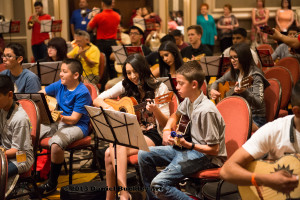 He hopes to have the film completed in 2018, and to follow up with a book on the subject. He hopes the film will inspire mariachi communities around the country to explore their roots and build towards a national understanding of the importance of America’s mariachi and folklorico movements.
He hopes to have the film completed in 2018, and to follow up with a book on the subject. He hopes the film will inspire mariachi communities around the country to explore their roots and build towards a national understanding of the importance of America’s mariachi and folklorico movements.
In the meantime he has begun a Kickstarter campaign to provide seed money to get the film started. Kickstarter is something called “crowd funding.” Rather than going to granting organizations and foundations, which he will in later stages of the production, Buckley is turning to ordinary people in the community to contribute small amounts in exchange for various rewards. These rewards range at various donation levels from specially created mariachi art buttons and t-shirts to copies of the completed film, a listing in the screen credits and more.
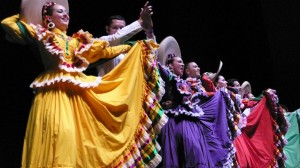 For more on The Mariachi Miracle go to http://www.mariachimiracle.com/
For more on The Mariachi Miracle go to http://www.mariachimiracle.com/
For information on Daniel Buckley go to http://www.danielbuckleyarts.com/home/bios/daniel-buckley-documentary-maker/
And if you know folks who you feel have important stories for the film, contact Buckley directly at dbtucson@gmail.com or 520-260-4176.

